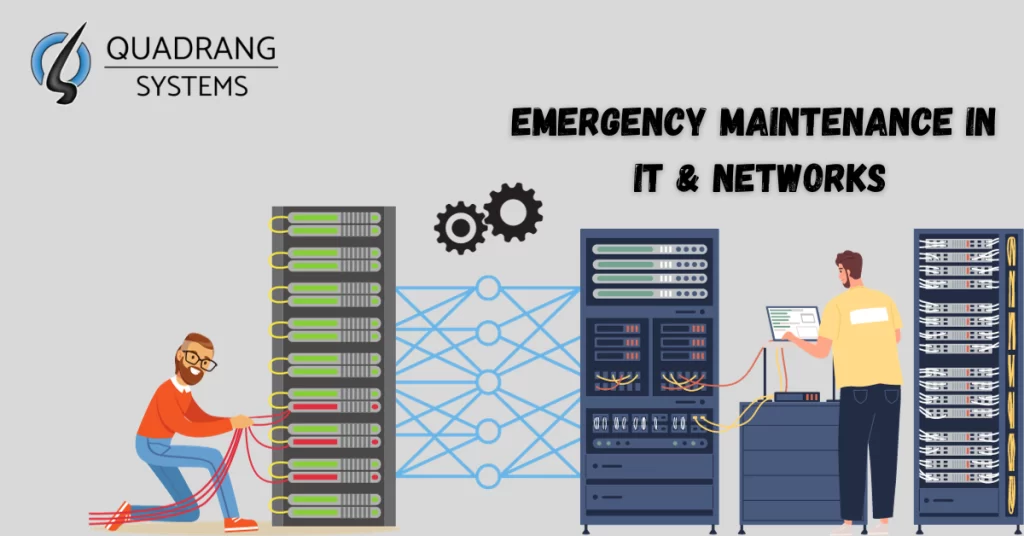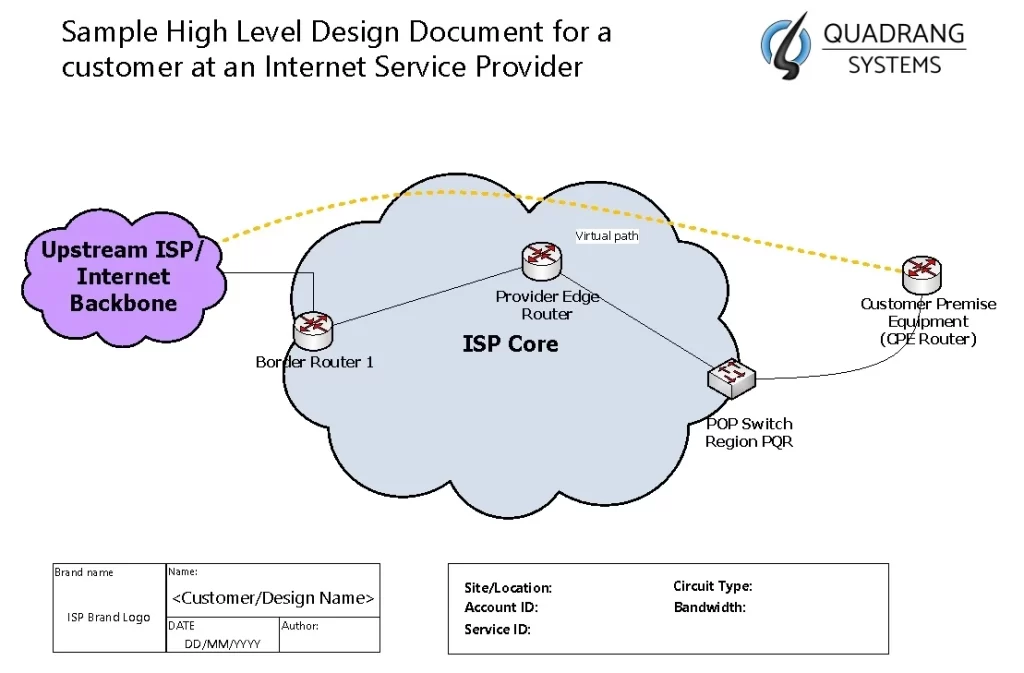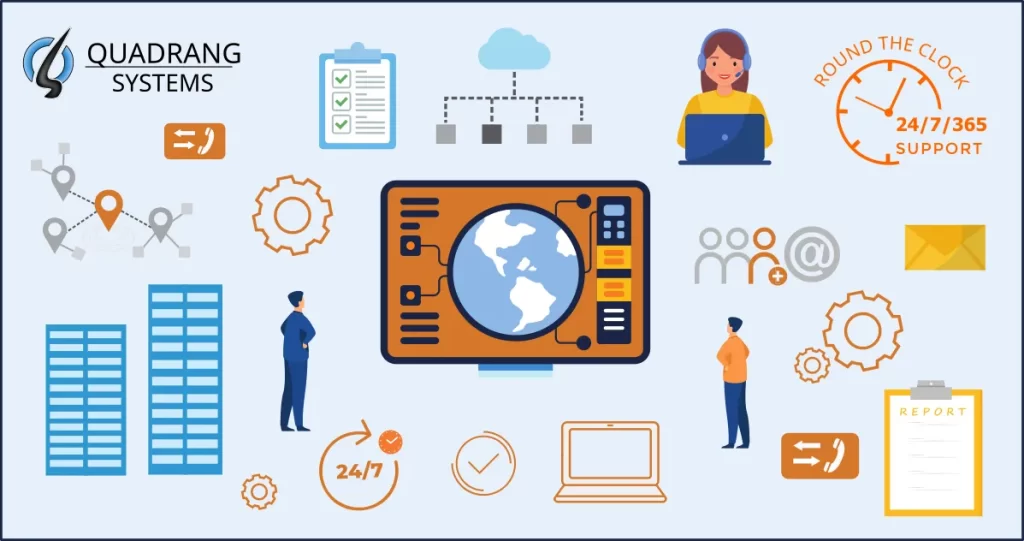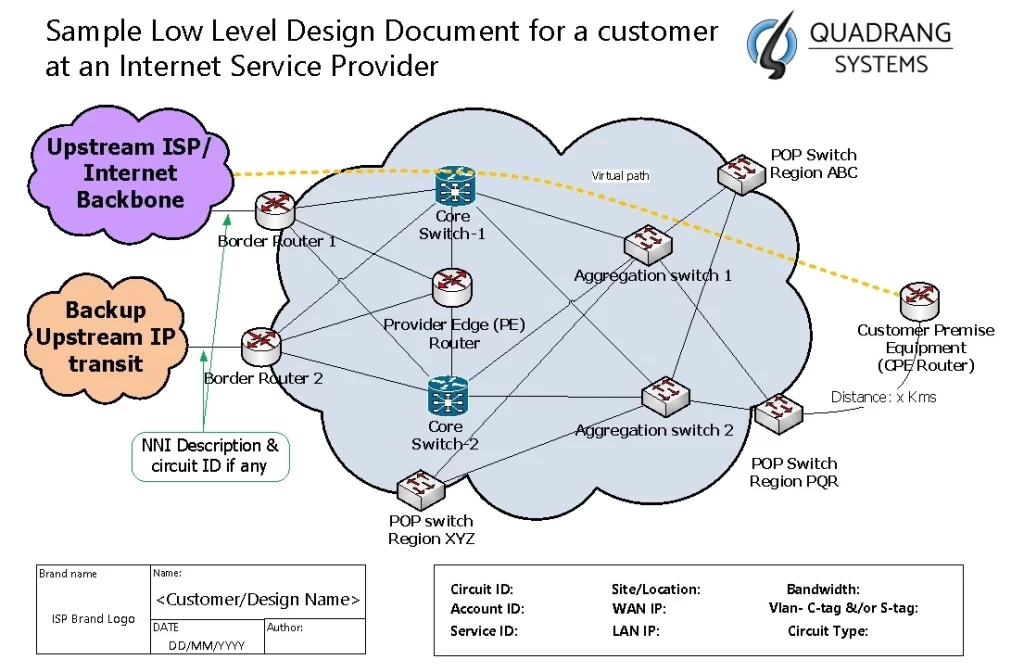Embarking on a new bespoke Network Project
Presale considerations on the new order
When a new corporate customer or business customer places a bespoke order with an ISP for connectivity to their branch/HQ, it initiates a structured network build lifecycle to deliver the required connectivity solution. The first step is gathering the customer’s requirements and parameters. The Presales and Sales team assess the requirements from the customer
Typical requirements include the service type, such as DIA (Dedicated Internet Access), EPL (Ethernet Private Line), or MPLS (Multi protocol Label Switching). The customer will also specify the bandwidth or speed needs, like 100 Mbps, 1 Gbps or 10 Gbps. Any specific resiliency needs, such as diversity or redundancy to meet defined SLA (Service Level Agreement) objectives, are also captured. The ISP Presales/Sales team put forth their recommendations and offer for providing a connectivity solution on top of customer requirements and customer makes the choice based on their needs and budget
With the requirements in hand, the project engineers can start developing two key design documents – the high-level design and the low-level design. This is sometimes done by the NOC team or a share responsibility between Presales, Projects and NOC. The senior network development engineers are asked for their inputs and advice while doing so.
Creating the High and Low-Level Designs (HLD, LLD)
The high-level design provides an abstract overview of the planned network using icons to represent sites, connections, and devices. It enables all stakeholders to understand the overall architecture and topology.
The low-level design contains the fine details showing exact locations, distances between sites, properties of the planned media (fiber, copper or microwave), fiber path, as well as equipment models, ports, and technical specifications of all equipment.
These designs are created in Microsoft Visio for easy sharing and collaboration. The designs may undergo several revisions based on feasibility feedback, survey results and customer change requests (CRs). Detailed designs greatly simplify the actual infrastructure rollout.
Leveraging Geospatial Information Systems
Geospatial Information System (GIS) maps and tools provide invaluable assistance for ground-up network planning, especially in greenfield locations. ISPs utilize GIS inputs to identify sites, survey terrain, select optimal paths, locate access points of presence (PoPs), and accurately estimate costs and materials.
GIS enables creating geo-coordinated project plans which minimize field disruptions during the physical build-out. Having reliable GIS data is crucial for building sustainable and future-ready networks.
Plotting the Optical Fiber
Fiber optic cabling forms the backbone of modern communications infrastructure due to its superior speed, capacity, security and reliability. The low-level design plots the fiber strands from end to end, mapping the optimal routes between locations.
Certain paths may necessitate additional protection such as conduit burying or aerial sheathing. Network planners source long-haul dark fiber links to interconnect critical locations. Engineers provide adequate capacity planning, keeping expansion requirements in mind, by designing appropriate fiber counts (12, 24, 48, 96 etc.) in each route.
Selecting the Correct Client Premises Equipment
The network design firm also selects relevant CPE (Customer Premise Equipment) to install at the user sites. Common CPE devices include routers, switches, firewalls, SD-WAN appliances etc. Models are chosen to suit the corresponding bandwidth, technology (TDM, Ethernet, DWDM) and feature needs.
The ISP ensures all active equipment is sized correctly and has sufficient capability, upgradability, redundancy and power supply provisions built-in. On the client side, uCPE and SD-WAN devices avail next-gen functionality.
Incorporating SD-WAN Considerations
Software-defined WAN architecture is a cutting-edge approach for business connectivity which overlays intelligent software abstraction over multiple underlying transport technologies. SD-WAN enables policy-based intelligent path selection, continuous monitoring and simplified centralized orchestration.
As Over-The-Top (OTT) SD-WAN solutions gain rapid industry acceptance, service providers need to assess incorporating SD-WAN components within their network designs depending on specific customer environments or application needs. This gives users unmatched flexibility to respond dynamically to changing business requirements.
Creating Configuration Change Requests
ISPs have established guidelines for standardized configurations across their network. Any deviations from these standards require raising a Configuration Change Request (CR).
CRs are also logged to activate new services, modify existing ones or decommission retired sites. Detailed step-by-step configuration changes are documented for review prior to approval and subsequent provisioning. Maintaining updated CRs helps synchronize changes across organization functions.
Compiling the Network Handover Document
After network construction completes, the implementation team puts together an exhaustive Handover Document. This encompasses logical and physical diagrams aligned with final on-ground execution, equipment datasheets detailing exact items deployed, final cabling plans, configuration and address lists, test results, and SLA commitments.
The handover document allows smooth transitioning newly built infrastructure for testing and certification prior to customer adoption. It serves as a permanent record for provisioning teams as well as operation and maintenance manuals for managing the live network.
Creating a Comprehensive Test Plan
Continuous testing across various phases instills quality into network builds. Structured test plans verify that all aspects of the implemented design match specifications, components integrate seamlessly and the entire system functions optimally under stress scenarios.
Testing stages may involve factory acceptance tests (FAT) for supplied equipment, site acceptance tests (SAT) for installed infrastructure combined with pre-service tests before launch. ISPs incorporate Failure Mode Effects Analysis (FMEA) to fortify resilience prior to final customer acceptance.
Defining the Circuit ID and Contacts List
A unique Circuit ID is assigned to each new network build for tracking and support purposes. The Circuit ID encapsulates vital identifying information regarding the specific solution, user endpoints, bandwidth speed, technology utilized etc.
An integral part of handover is listing key contacts for fault reporting, escalations and incident management support. This quick reference contact list is shared with customer IT and network teams enabling them to obtain swift assistancen whenever required.
A How-To Guide for New Age ISPs
Launching and sustaining an ISP in today’s digital era necessitates mastering numerous next generation capabilities. Here is a handy how-to guide:
Building Robust and Scalable Platforms Leverage SDN, next-gen edge computing and virtualization technologies to future-proof service delivery platforms and simplify operations. Maintain modular designs supporting open standards and APIs for interoperability.
Enabling Automation Automate configurations, monitoring, diagnostics, reporting and fulfillment workflows to shorten delivery timeframes and lower costs. Maintain libraries of pre-built templates to accelerate onboarding.
Embracing the Cloud Eco-system Imbibe cloud-native principles for efficiency, resilience and time-to-market. Offer managed hybrid multi-cloud solutions encompassing connectivity, security, marketplace and professional services.
Analyzing Data to Optimize User Experience Apply big data analytics and self-learning algorithms to gain contextual user insights from network data. This helps customize offerings aligned with usage patterns for superior digital experiences.
Launching Over-The-Top Network Services Leverage cloud innovations in SDN and NFV to propel Over-the-Top unified connectivity and security services. Maintain lean platforms supporting rapid feature upgrades.
Transitioning Skill Sets to Emerging Technologies Encourage upskilling and knowledge sharing to build competencies in software engineering, data science and cloud-based delivery. Change mindsets to amplify capabilities.
Fostering Agile Partnerships Forge strategic relationships combining complementary domain expertise and intellectual property through APIs and ecosystem frameworks. Co-innovate to expand solution breadth.
Prioritizing Outstanding Customer Experiences Make customer transparency, self-service capabilities, predictable outcomes and issue resolution integral components of company culture for enriching user journeys.









